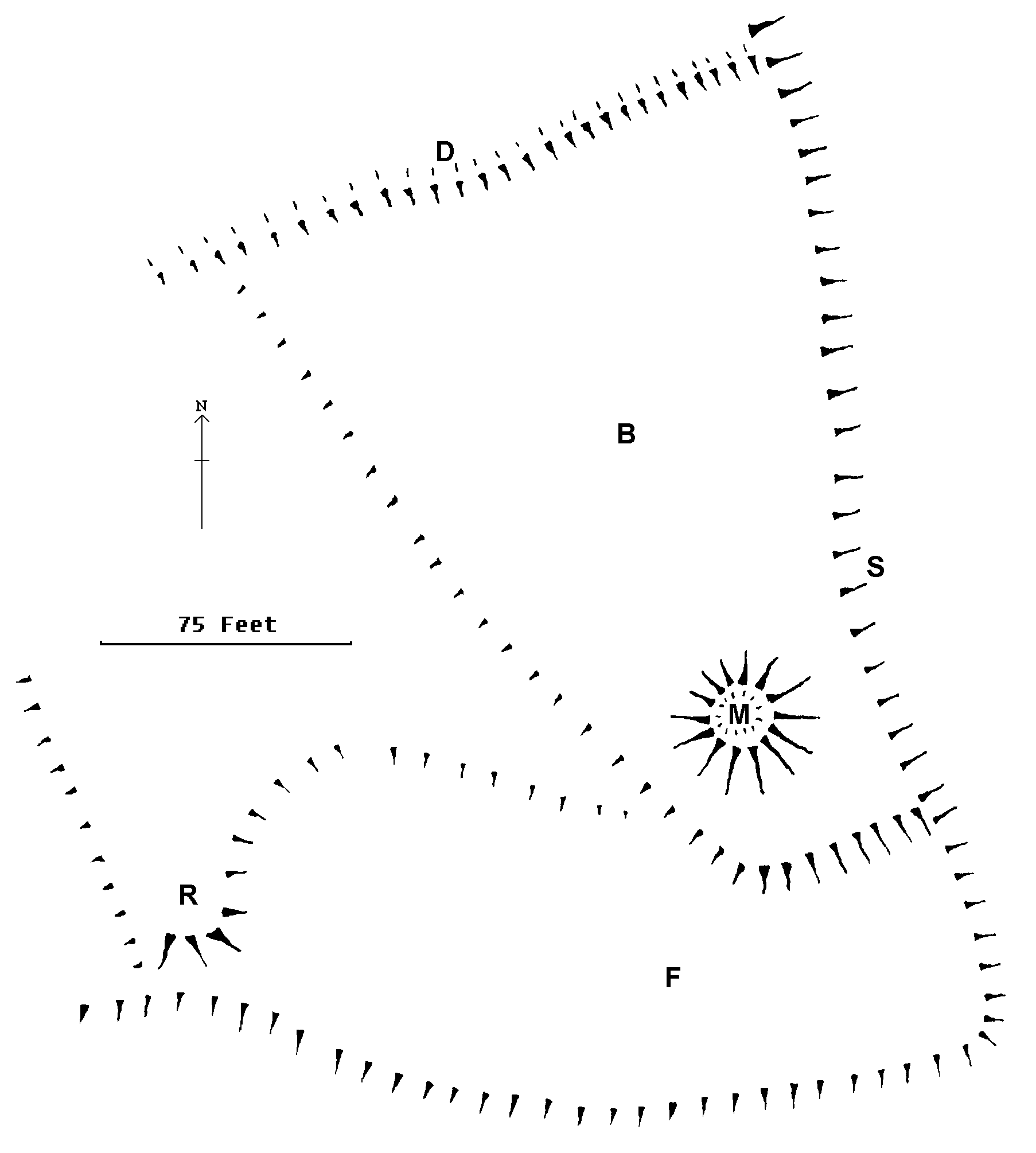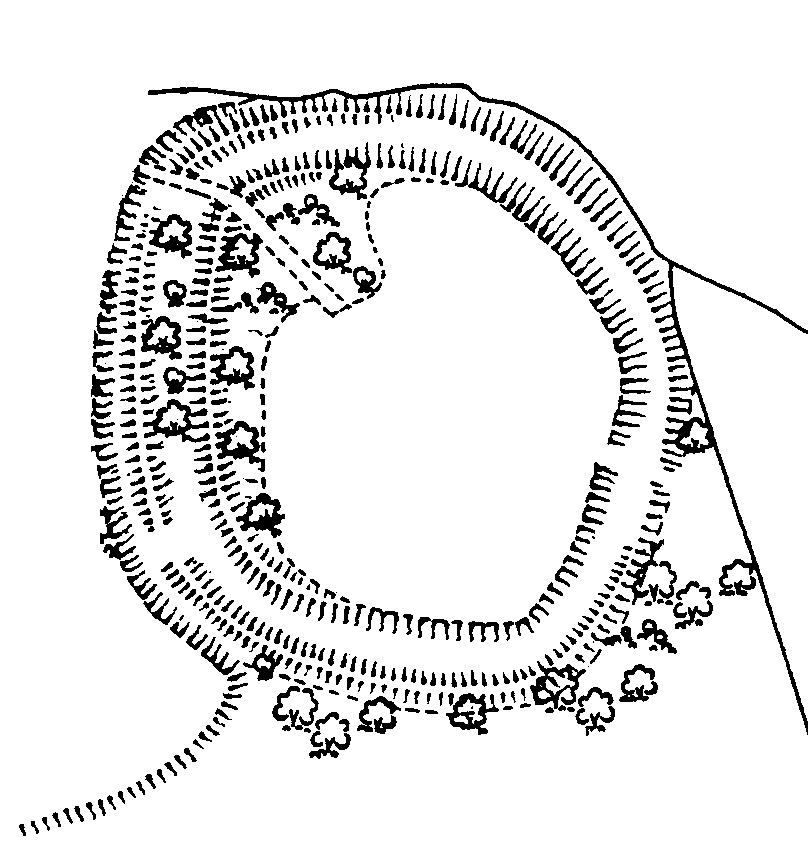Llyswen 'Motte'
 This
‘castle’ at Grid Reference SO.131376 has been dismissed in Castellarium
Anglicanum as a tree ring. The site today consists of a mound set on a
projecting spur above the village. The mound (M) was only about 6' above
the platform (B) to the north, but more like 25' above the field to the
south. No ditching was discovered at all, although much loose stone was
discovered in the 'rampart' on the motte and in the field boundaries, whose
'ramparts' seemed more substantial than mere boundaries. In World War II a
'command post' was dug into the 'motte' top according to two local residents,
though what this work consisted of is now impossible to ascertain. What is
certain, however, is that even only one gun emplaced here would have had a
marvellous
view down the Wye valley. The considerations of strategy do not change over the
millennium.
This
‘castle’ at Grid Reference SO.131376 has been dismissed in Castellarium
Anglicanum as a tree ring. The site today consists of a mound set on a
projecting spur above the village. The mound (M) was only about 6' above
the platform (B) to the north, but more like 25' above the field to the
south. No ditching was discovered at all, although much loose stone was
discovered in the 'rampart' on the motte and in the field boundaries, whose
'ramparts' seemed more substantial than mere boundaries. In World War II a
'command post' was dug into the 'motte' top according to two local residents,
though what this work consisted of is now impossible to ascertain. What is
certain, however, is that even only one gun emplaced here would have had a
marvellous
view down the Wye valley. The considerations of strategy do not change over the
millennium.
 Above
the supposed castle site of Llyswen lies what has been classified as a
hill-fort. This was visited on the Woolhope Club ARS recce, but it was decided
that the time taken on the steep climb up to the site would preclude a visit on
the day. However the recce team were not at all happy with the classification of
the site. Although the plan on the 25" OS maps was accurate it did not
convey the fact that the site is built not on a hill-top, but on a quite
considerable slope. On the up-hill side were powerful twin ramparts which fairly
obviously once included substantial masonry defences. The other three sides of
the roughly rectangular hill-fort showed no such substantial works, merely an
impressive ditch and slight inner rampart. The downhill side which appears to
have included the entrance also had twin ramparts, but nothing as impressive as
those that guarded the up-hill north side. Modern waterworks have damaged the
powerful northern front and make the breaks in this rampart suspect. A pond has
also been added in the south-west corner of the fort ditch.
Above
the supposed castle site of Llyswen lies what has been classified as a
hill-fort. This was visited on the Woolhope Club ARS recce, but it was decided
that the time taken on the steep climb up to the site would preclude a visit on
the day. However the recce team were not at all happy with the classification of
the site. Although the plan on the 25" OS maps was accurate it did not
convey the fact that the site is built not on a hill-top, but on a quite
considerable slope. On the up-hill side were powerful twin ramparts which fairly
obviously once included substantial masonry defences. The other three sides of
the roughly rectangular hill-fort showed no such substantial works, merely an
impressive ditch and slight inner rampart. The downhill side which appears to
have included the entrance also had twin ramparts, but nothing as impressive as
those that guarded the up-hill north side. Modern waterworks have damaged the
powerful northern front and make the breaks in this rampart suspect. A pond has
also been added in the south-west corner of the fort ditch.
Considering the peculiarity of the two sites at Llyswen the following speculations can be made. Firstly that the hill fort is in fact the site of the Dark Age court from which Llyswen (the White Court) takes its name. Such llys are notoriously difficult to find. Secondly that the castle lower down the hill is its successor. If this is so the large outer defences at the 'castle' may well mark a large courtyard in which a later llys stood when the high lying earlier defences were abandoned in favour of a more accessible and hospitable site. If this speculation is correct it would suggest that Llyswen was the centre of a now lost commote within the debatable land of Cantref Selyf. Due to the nature of the Norman conquest of South Wales most of the old commotal structure of the cantrefs have been lost or disfigured beyond certain reconstruction, so such a scenario is not impossible. What we do know of the area is that it was under the control of the Cliffords by 1175 (Gwenddwr and Nanteglwys to the north and Bronllys to the south) and that this was either due to the land being granted them by the Hereford lords of Brecon or less likely by the Tosny family (Painscastle and Glasbury), both of whom were holding lands in these districts from the earliest days of the Norman conquest of South Wales.
Order Four Castles of the River Wye through the PayPal basket below.